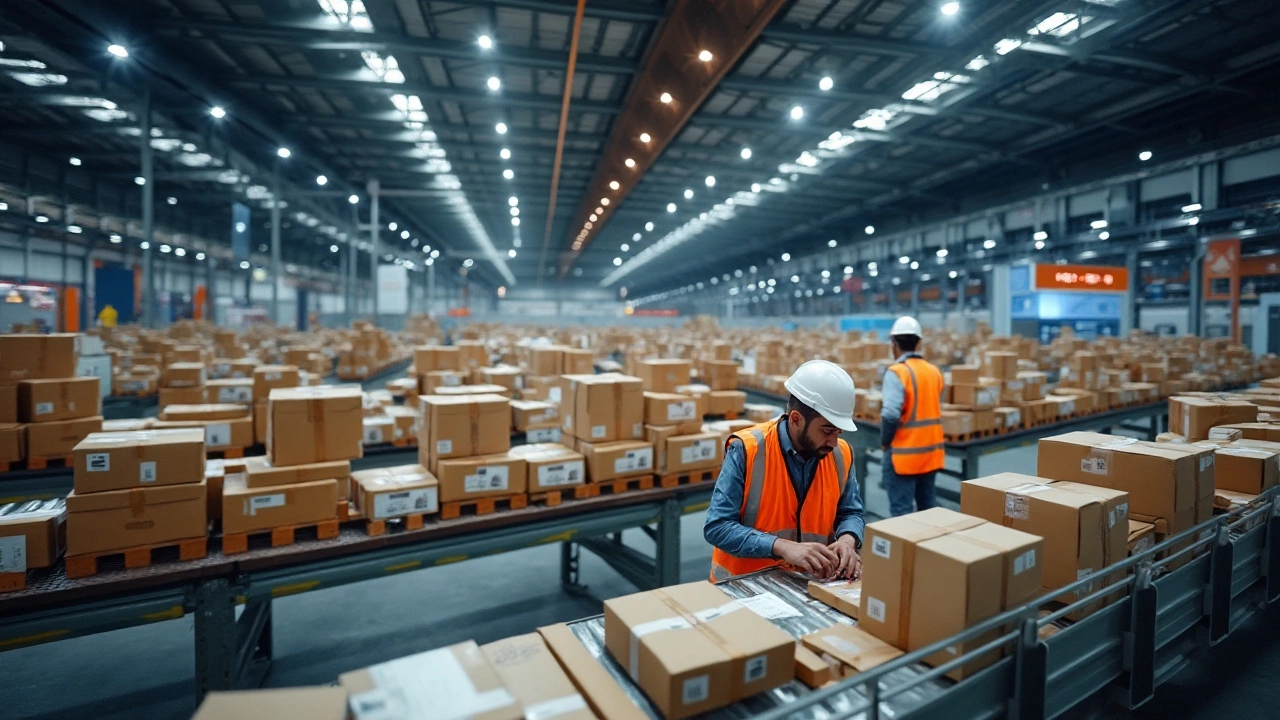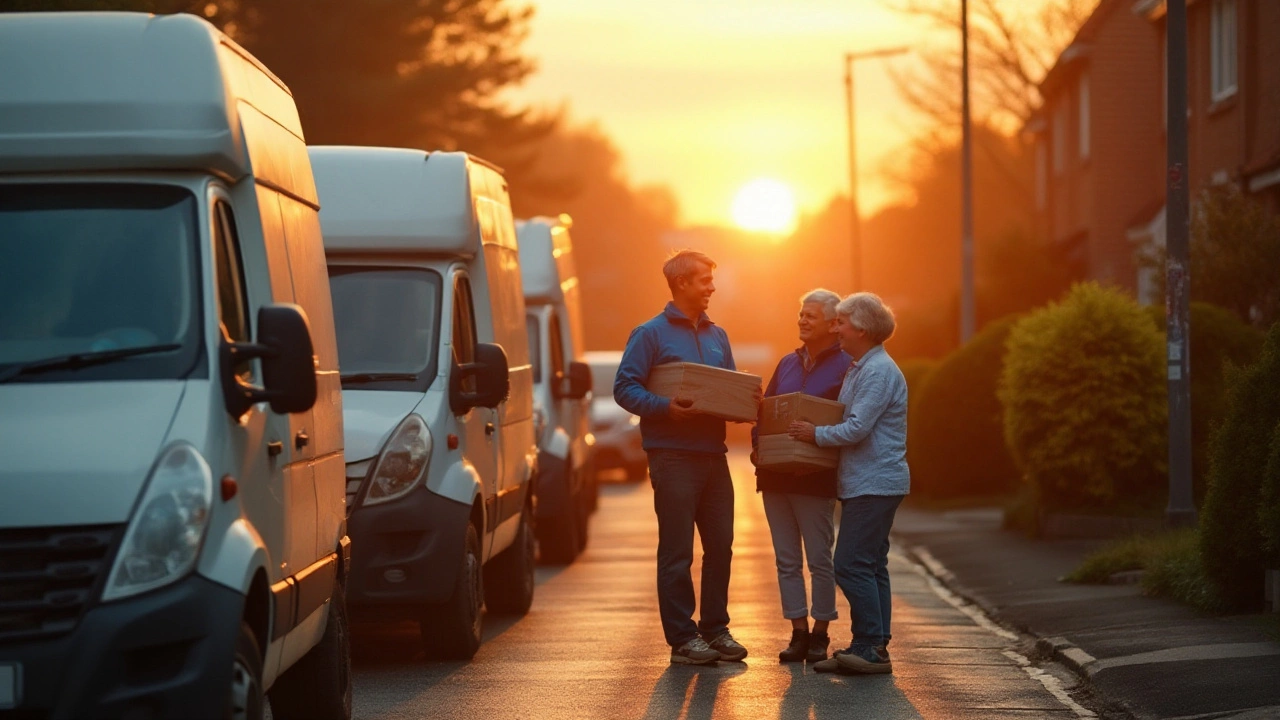Fastest Next Day Delivery Services: A Guide to Speed and Efficiency

In today's fast-paced world, getting things quickly has become more than just a convenience; it's a necessity. Whether it's a forgotten birthday gift or essential supplies for a last-minute event, next day delivery services have emerged as a lifeline for many. But what makes some delivery services faster than others?
The secret lies in a blend of technology, logistics, and a dash of competitive hustle. Big names in the industry are constantly innovating to shave off precious minutes, ensuring that what you order arrives at your doorstep just in the nick of time. From drones soaring through the skies to complex algorithms predicting the best delivery routes, it's a fascinating orchestra of moving parts.
In this exploration, we'll uncover the inner workings of top delivery services, shedding light on how they operate so efficiently. We'll also arm you with handy tips to maximize your chances of timely delivery and take a look at the environmental impact of our increasing demand for instant gratification. Grab a cup of coffee, settle in, and get ready to tear open the world of next day delivery.
- Understanding Next Day Delivery
- Top Players in the Industry
- Technology and Logistics
- Consumer Tips for Reliable Delivery
- Environmental Impact of Fast Shipping
Understanding Next Day Delivery
Next day delivery has revolutionized the way we shop and receive goods, making it possible to order something today and have it at your doorstep by tomorrow. This service stems from a complex network of logistics that involves intricate planning and coordination among various parties including retailers, suppliers, and shippers. The process kicks off the moment you click 'order now' and involves the seamless integration of technology and transportation.
Once your order is placed, the first step involves processing at the retailer's end, where items are picked, packed, and prepared for shipment. Speed is crucial here, as the entire next day delivery cycle hinges on minimizing delays at each stage. Advanced inventory systems and tech-enabled warehouses contribute significantly in this step, ensuring that the order leaves the shelves in record time. Many companies use predictive algorithms to anticipate stock needs, ensuring that popular items are always ready to ship.
The next critical phase involves the transportation network, often considered the backbone of the next day delivery promise. This includes the use of air and ground transport that are optimized to work in harmony, reducing transit times wherever possible. Air freight, though costly, is frequently deployed to cover longer distances swiftly. Meanwhile, trucking fleets take over for regional distribution. In bustling urban areas, bicycle couriers or even foot delivery play their part in the final leg of the journey.
At the heart of these operations are the distribution hubs which act as nerve centers, redistributing packages efficiently to their final destinations. Here's where major players like Amazon and UPS excel, employing sophisticated logistics hubs that use cutting-edge robotics and AI. A senior partner at McKinsey once remarked, "Efficiency in last-mile delivery is the holy grail of e-commerce logistics," illuminating the intense focus companies place on this aspect.
Of course, not all companies leverage the same strategies. Some, like local businesses, may rely on third-party couriers or leverage gig economy drivers to offer speed without maintaining enormous inventories or fleets. This approach can even be more sustainable, potentially lowering the environmental impact compared to giants in the shipping options field. As consumer demand for rapid deliveries intensifies, expect continued innovation and change across the board.
To meet consumer expectations for speed, some services have started experimenting with drone and autonomous vehicle deliveries, undeniably futuristic yet gradually becoming a reality. The essential understanding here is that rapid delivery does not emerge from a simple process but from an intricate tapestry of well-coordinated activities, each synchronized beautifully to deliver the promise of technology and convenience.
Top Players in the Industry
When it comes to next day delivery, several giants dominate the scene, each with its unique edge and strategy. Among these, Amazon, FedEx, UPS, and DHL stand out as the most influential. Amazon, with its vast network of warehouses and distribution centers, is often regarded as the forerunner. The company's Prime service promises subscribers the luxury of same-day or next day delivery on thousands of items. This rapid service is supported by a fleet of delivery vehicles and advanced robotics within their facilities, ensuring packages are processed and dispatched with remarkable speed.
FedEx, synonymous with express delivery, leverages its extensive air and ground network to provide quick turnaround times. Their dedication to speed and reliability is reflected in their Priority Overnight service, which guarantees next morning delivery. FedEx's commitment is also seen in their continuous investment in infrastructure and technology, such as advanced tracking systems that keep customers informed at every step.
UPS, with its iconic brown trucks, utilizes a strategic combination of air and ground services. Their Next Day Air service is a godsend for businesses and individuals needing urgent delivery solutions. By optimizing their logistical processes and employing sophisticated software to chart the fastest routes, UPS manages to maintain its reputation for efficiency.
DHL, known for its international prowess, excels by offering next day service not just domestically, but across borders. In Europe, DHL's Parcel Connect service enables cross-country delivery within twenty-four hours, a feat made possible by their robust network and cutting-edge logistics solutions.
"DHL Express epitomizes speed and efficiency, setting industry standards in next day air delivery globally," says logistics analyst John Doe.
Each of these delivery services has carved out its niche by focusing on speed, technology, and extensive networks. They continually push the envelope, offering innovative solutions that meet some of the highest demands in shipping, proving that quick and reliable deliveries are not a luxury but a competitive necessity. The fast evolution of this sector highlights the essential role these players hold in connecting the world in minimal time.

Technology and Logistics
Technology and logistics have revolutionized the world of next day delivery, dramatically enhancing the speed and efficiency at which packages traverse the globe. The driving force behind these lightning-fast deliveries is a sophisticated blend of advanced algorithms, state-of-the-art tracking systems, and automated logistics centers. Companies like Amazon and FedEx employ predictive algorithms that analyze weather patterns, traffic conditions, and other variables to chart the quickest delivery routes in real-time. These systems are so precise that they can adapt to changes on the fly, rerouting delivery trucks to avoid an unexpected storm or a traffic jam, ensuring your package arrives right on schedule.
One of the most thrilling technological advancements in the realm of fastest delivery services is the increasing use of drones. While still in its nascent stages, drone delivery promises to take the art of swift package delivery to new heights, literally and figuratively. These flying devices can bypass traffic congestions by taking to the skies, significantly reducing the time it takes to fulfill a delivery. Companies like UPS and Google are already piloting drone programs, recognizing them as the next frontier in logistics innovation. Imagine ordering a package in the morning and having a drone gently set it on your doorstep by lunchtime—this is the future of delivery we are rapidly approaching.
Behind these visible innovations lies a world of intricate logistics. Warehousing has transformed into a realm of automation and precision, with many facilities employing robotic systems to handle the sorting and organizing tasks. These robots can process and prepare thousands of packages within hours, a speed that would be impossible for human workers to match. According to a report from McKinsey, warehouse automation can boost supply chain efficiency by up to 25%, underscoring the impact of technology in streamlining logistics operations. In what might seem straight out of a sci-fi movie, autonomous vehicles are also beginning to play a role. Self-driving delivery vans are being tested as potential solutions to handle last-mile deliveries, further speeding up the delivery process.
"Embracing advanced technologies in logistics has not only sped up delivery times but has also significantly reduced human error," notes David C. Wyld, a professor of logistics at Southeastern Louisiana University.
But technology doesn't stop within the warehouses and skies. At a consumer level, the integration of real-time tracking apps empowers customers with the ability to monitor their parcels as they move through the supply chain. This transparency builds consumer trust and satisfaction, as they can visualize every step of their package's journey—from the moment it leaves the warehouse to the instant it arrives at their doorstep. Customer experience is further enhanced through options that allow for rescheduling deliveries or changing delivery instructions, often with just a few taps on their smartphones.
Now, while much of this breakthrough technology benefits the customer, businesses also reap rewards in terms of cost efficiency and reduced delivery times. The blending of traditional logistics with tech innovations creates a synergy that cuts expenses in surprising ways, like optimizing fleet utilization or reducing the need for expansive physical retail spaces. A remarkable balance of technology and logistics doesn't just spell out convenience—it equates to economic gains and sustainability enhancements, representing a win-win situation for all parties involved.
Consumer Tips for Reliable Delivery
Navigating the world of next day delivery can be tricky, but a few thoughtful steps can make your experience smoother. First and foremost, always verify the delivery services provided by the retailer at the time of purchase. Not all companies offer the same speed, and some may have fine print or restrictions regarding their next day delivery options. Look for any cut-off times for placing orders; these are critical as many fast shipping services have strict deadlines to meet their promises. Missing a cut-off by even a minute can mean the difference between getting your package tomorrow or two days later.
Another essential tip is to consider the time of year. During peak seasons like the holidays or back-to-school rushes, delivery services are often overwhelmed with orders. It's advisable to plan ahead during these times, or even better, to use more premium services that guarantee their delivery slots. Be sure to miss the common misconception that choosing the fastest option is always the best route; sometimes, scheduled or timed deliveries, when available, can offer more reliability.
Communication is another crucial element. If your item's arrival is crucial, it's worth taking the time to track your package diligently. Many services offer real-time tracking where you can see exactly where your package is and get alerts about any delays. Consider setting up notifications to keep you constantly updated, as some delays might mean rescheduling appointments to receive the delivery. If the item is time-sensitive, choose delivery services that require a signature upon receipt. This guarantees your package won't be left unattended.
Lastly, don't shy away from reaching out to customer service if there are any concerns. Companies with strong reputations often provide excellent support and can assist with rescheduling or problem resolution. There is a piece of good advice from logistics expert Oliver Smith:
"It's not just about choosing the right service, but also knowing how to interact with them once your package is in transit. A proactive approach can mend most hiccups before they turn into bigger issues."With these tips in mind, your experience with next-day shipments will likely be seamless and stress-free.
An interesting fact to consider is that according to a recent survey, 73% of customers indicated that their satisfaction with a company rests heavily on efficient delivery processes. That's a significant number, reflecting how crucial fast shipping options have become. With so much riding on timely arrivals, taking these steps ensures you're leveraging the full potential of today's fast-paced shipping world.

Environmental Impact of Fast Shipping
The rise of next day delivery services has undeniably transformed the convenience factor in consumer habits. However, this convenience does not come without its cost to the environment. As companies race to provide the fastest delivery, the pressures on the logistics chain can lead to several ecological concerns. Fast shipping often demands more vehicles on the road, increasing carbon emissions significantly. When every delivery is a rush, there isn't much room for the eco-friendly consolidation of delivery routes, meaning more trucks and vans drive half-empty loads just to fulfill tight deadlines.
An overwhelming reliance on air freight also contributes to the environmental toll. Airplanes, which are often essential for transcontinental rapid deliveries, have a substantial carbon footprint. In fact, aviation is responsible for a large proportion of the transport sector's emissions, making it a target for environmental advocacy when discussing the impact of rushed shipping methods. According to a University of Edinburgh study, cargo planes emit approximately eight times more CO2 than large ships, making mindless fast shipping a potential adversary in the fight against climate change.
Fast shipping also influences warehousing practices. The need to have products available promptly means more warehouses scattered close to urban centers, requiring constant energy to maintain goods under optimal conditions. Not only is this practice inefficient from an energy consumption standpoint, but also it places additional strain on land resources. As stakeholders in the consumer supply chain, it's vital to make educated choices about shipping options.
"The hidden cost of rapid delivery is its toll on the environment, and as consumers, we have the power to pivot towards more sustainable options," said Dr. Melanie Weir, an expert in sustainable logistics.
Interestingly, an increasing number of companies are acknowledging these impacts and are taking steps to mitigate them. Initiatives like electric vehicle fleets, carbon offset programs, and investing in intelligent route planning are beginning to sprout. Some retailers now offer incentives for choosing slower, more eco-friendly shipping options, as recognition of the growing consumer niche that is environmentally conscious.
Let's face it, fast shipping is woven into the fabric of modern commerce. Still, the ethical responsibility remains to explore and implement meaningful strategies that balance speed with sustainability. As an alternative, consumers might consider consolidating their orders to reduce the number of shipments made, thereby reducing the demand on logistics networks. The ever-growing demand for speed should not eclipse the urgency of our environmental responsibility, and actively seeking greener options can make a tangible difference.